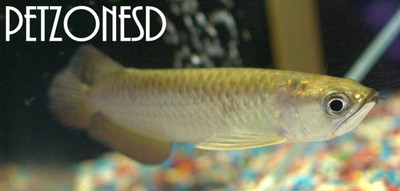Jardini Arowana
Posted by Max Gandara on on 15th Jun 2025
Jardini Arowana: The Regal Predator of Freshwater Aquariums
The Jardini Arowana (Scleropages jardinii), also known as the Pearl Arowana or Gulf Saratoga, is a striking freshwater predator admired for its power, grace, and metallic sheen. Native to northern Australia and parts of Papua New Guinea, this species commands attention not only for its beauty but also for its bold personality and predatory nature.
Whether you’re a seasoned aquarist or an adventurous hobbyist looking to step into the world of large, exotic fish, the Jardini Arowana is a remarkable centerpiece that offers both challenge and reward.
Striking Appearance
Jardinis boast a distinctive look:
-
Metallic silver to bronze scales, often with a pink or gold shimmer
-
Each scale may be outlined, creating a “pearl-like” or iridescent pattern
-
Long, slender body and large, paddle-like pectoral fins
-
Typical adult behavior includes slow, deliberate swimming near the surface—adding to their regal presence
Though similar in form to the more commonly known Asian Arowana, Jardinis tend to be more accessible and slightly less regulated in many countries.
Temperament and Behavior
While visually stunning, Jardini Arowanas are known for their aggression—often more so than their South American or Asian counterparts. They are territorial and highly predatory, particularly toward smaller tankmates. This makes them best suited to species-only setups or tanks with similarly sized, robust fish.
Expect a bold fish with a strong feeding response, a bit of attitude, and a tendency to patrol the tank’s upper layers like a silent guardian.
Tank Requirements
Because of their size and behavior, Jardinis need a large, well-maintained setup:
? Tank Size:
-
Minimum: 180 gallons (680+ liters) for a single adult
-
Larger is always better, especially for long-term care
? Environment:
-
Minimalist aquascape with open swimming space
-
Driftwood, large rocks, and hardy plants can be used sparingly
-
Secure lid is essential – Arowanas are notorious jumpers
? Water Conditions:
-
Temperature: 75–82°F (24–28°C)
-
pH: 6.5–7.5
-
Ammonia/Nitrite: Always 0
-
Water changes: Frequent and consistent to maintain pristine quality
Feeding
Jardinis are carnivorous and require a protein-rich diet:
-
Primary foods: Frozen or live fish, shrimp, krill, and insects
-
Supplement with: High-quality pellets for carnivorous fish
-
Avoid: Overfeeding, fatty meats (like beef heart), or feeder fish from uncertain sources (due to disease risk)
A varied diet promotes vibrant coloration, healthy growth, and natural behaviors.
Tankmates: Proceed with Caution
Due to their aggressive and solitary nature, choosing tankmates for a Jardini Arowana requires care. Suitable companions (with a large tank and good planning) may include:
-
Silver Dollars
-
Bichirs
-
Large Catfish (e.g., Plecos or Paroon Sharks)
-
Other similarly sized, non-aggressive cichlids
Avoid anything small enough to be eaten or too aggressive to cohabitate.
Breeding and Availability
Breeding Jardini Arowanas in captivity is rare and complex. They are mouthbrooders, with males incubating eggs in their mouths. However, due to their aggression and space requirements, intentional breeding is rarely attempted outside of professional facilities.
Jardinis are generally more available and affordable than Asian Arowanas, making them a popular alternative for enthusiasts looking for a large, exotic fish without the legal restrictions.
Final Thoughts: A Living Dragon for the Dedicated Aquarist
The Jardini Arowana is not for the casual hobbyist. It demands space, respect, and responsible husbandry. But for aquarists ready to meet its needs, it offers a majestic presence, a touch of the wild, and the rare satisfaction of keeping one of nature’s most elegant aquatic predators.
If you're ready to invest in a stunning centerpiece that turns heads and commands attention, the Jardini may be the perfect crown jewel for your aquarium.
Have questions or experiences with Jardinis? Drop them in the comments or share your setup – we’d love to see your freshwater monster in action!

